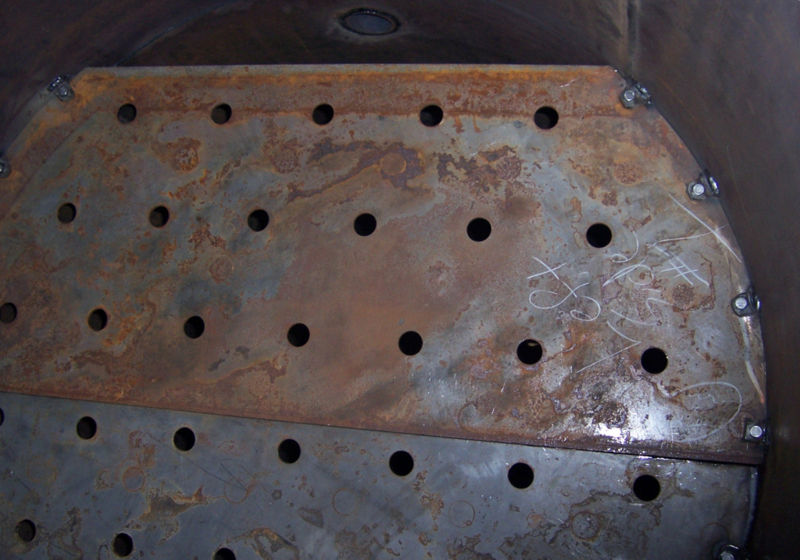 Wave breaker is a component or structure installed inside a pressure vessel to mitigate or control the formation of waves or sloshing of liquids within the vessel. Pressure vessels are containers designed to hold fluids or gases under high pressure, and they are commonly used in various industrial processes, including chemical manufacturing, oil and gas refining, and power generation.
Wave breaker is a component or structure installed inside a pressure vessel to mitigate or control the formation of waves or sloshing of liquids within the vessel. Pressure vessels are containers designed to hold fluids or gases under high pressure, and they are commonly used in various industrial processes, including chemical manufacturing, oil and gas refining, and power generation.
In long horizontal vessels it is necessary to install wave breakers or stilling baffles, which are nothing more than vertical baffles spanning the gas-liquid interface and perpendicular to the flow. Wave breakers serve multiple functions. By minimizing the amount of waves, the oil & water separation process is stabilized. This prevents large amounts of wet oil from spilling over the weir. This is particularly undesirable if the separator is being used for gross allocation or lease custody transfer. In a process that has a lot of gas entrainment, they are designed to stop wave action caused by gas eddy currents near the gas-liquid interface in order to prevent liquid re-entrainment into the gas stream.
Wave Breaker Advantages and Disadvantages
|
|---|
| Advantages | Disadvantages |
|---|
- The primary purpose of wave breakers is to minimize the sloshing motion of liquid inside a tank during transportation or agitation. This is particularly important in applications where excessive sloshing can lead to instability and safety concerns.
- Wave breakers contribute to the stability of liquid cargo in tanks. By reducing sloshing, they help maintain a more stable center of gravity, preventing the liquid from shifting and potentially causing the tank or vessel to become unbalanced.
- In transportation applications, such as in tank trucks or ships, wave breakers can improve the handling characteristics of the vehicle. By minimizing sloshing, they help maintain control and stability during acceleration, deceleration, and turns.
- Wave breakers prevent the occurrence of liquid surges inside the tank. Surging can lead to sudden shifts in the liquid mass, potentially causing damage to the tank structure or affecting the integrity of the stored material.
- By reducing the dynamic forces associated with sloshing, wave breakers help protect the tank structure and components from the stresses and strains that may occur during transportation or other dynamic conditions.
|
- Designing effective wave breakers requires careful consideration of factors such as tank geometry, liquid properties, and operational conditions. Achieving optimal performance may involve complex engineering analysis.
- In certain conditions, wave breakers may induce resonance, leading to amplified sloshing rather than reducing it. The design must account for resonance frequencies to avoid unintended consequences.
- Wave breakers occupy space within the tank, which can affect the overall storage capacity. This may be a limitation in applications where maximizing storage volume is critical.
- Retrofitting existing tanks with wave breakers can be challenging, and the effectiveness of the wave breakers may depend on proper installation. New tanks may need to be designed with wave breakers in mind.
- Wave breakers may be more beneficial in certain applications, such as liquid transportation, and may have limited relevance in stationary storage tanks. Their effectiveness may vary based on the specific operational conditions.
|
Key Points about Wave Breakers
The design and placement of wave breakers depend on the specific application, the characteristics of the fluid inside the vessel, and the vessel's operating conditions. They can take various forms, such as baffles, perforated plates, or other structures that interrupt the flow of liquid or gas. The primary goal is to create a more stable environment inside the pressure vessel and ensure its safe and efficient operation.
Preventing Wave Formation - When a pressure vessel is partially filled with liquid, especially in cases where the vessel experiences sudden changes in pressure or is subject to movement, waves can form on the surface of the liquid. These waves can potentially lead to instability, increase stress on the vessel's walls, and affect the performance of the equipment connected to the vessel. Wave breakers are designed to disrupt the formation of waves or reduce their size, which helps maintain stability within the vessel.
Enhancing Mixing - In some applications, it's desirable to have controlled mixing of liquids within a pressure vessel. Wave breakers can be designed to promote turbulence and mixing, which can be useful in chemical reactions or other processes that require thorough blending of fluids.
Reducing Fluid Splashing - In certain situations, pressure vessel contents may be sensitive to shear forces or sudden changes in fluid dynamics. Wave breakers can minimize splashing and abrupt movements within the vessel, thus reducing the potential for damaging the contents.

 Wave breaker is a component or structure installed inside a pressure vessel to mitigate or control the formation of waves or sloshing of liquids within the vessel. Pressure vessels are containers designed to hold fluids or gases under high pressure, and they are commonly used in various industrial processes, including chemical manufacturing, oil and gas refining, and power generation.
Wave breaker is a component or structure installed inside a pressure vessel to mitigate or control the formation of waves or sloshing of liquids within the vessel. Pressure vessels are containers designed to hold fluids or gases under high pressure, and they are commonly used in various industrial processes, including chemical manufacturing, oil and gas refining, and power generation.
